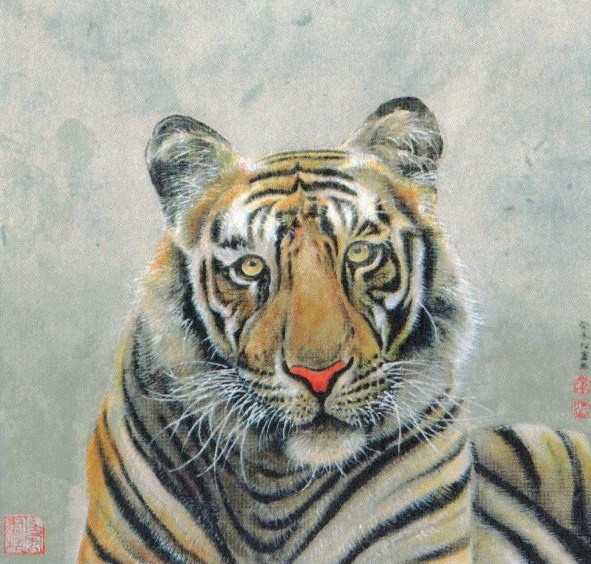
The Tiger (虎) is the third of the 12-year cycle of animals in the Chinese zodiac. The Year of the Tiger is associated with the Earthly Branch (地支) symbol of Yin (寅). The Lunar New Year Day of the Year of Ren Yin (壬寅年) falls on Tuesday 1 February 2022.
The Chinese lunar calendar is made up of ten Heavenly Stems and 12 Earthly Branches as follows:
天干 (Ten Heavenly Stems) – 甲乙丙丁戊己庚辛壬癸
地支 (Twelve Earthly Branches) – 子丑寅卯辰巳午未申酉戌亥
十二生肖 (12-year cycle in the Chinese zodiac) is made up of
鼠牛虎免龍蛇馬羊猴雞狗豬
rat ox tiger rabbit dragon snake horse goat monkey rooster dog pig, as show in the diagram below:
Recent years of the Tiger are: 1926, 1938, 1950, 1962, 1974, 1986, 1998, 2010, 2022.
Chinese Zodiac years are based on the Chinese lunar calendar. Interested people born in January or February can check the date of the Chinese New Year to confirm their birth sign, for example at the following site:
https://www.chinahighlights.com/travelguide/chinese-zodiac/tiger.htm
Tigers are the biggest and most powerful members of the cat family (family Felidae). They are native to isolated areas of Asia and east Russia. A tiger is solitary in nature, marking out its territory and defending it from other tigers. In order for it to survive and thrive in its own habitat, the tiger has powerful physical features from razor-sharp teeth to muscular legs. They catch prey and put up a fight from potential poachers.
The tiger has incited a sense of both awe and admiration: its prowess, its ferocity and its beauty. The tiger is full of life and embodies the spirit and drive to achieve and make progress.
Around 3,900 tigers remain in the wild across the globe, according to World Wildlife Fund. Since the beginning of the 20th century, over 95% of the world’s tiger population is lost. India currently hosts the largest tiger population.
Almost every part of a tiger has been used in folk or traditional Chinese medicine. It is believed that the bones of tigers contains ingredients that can relieve rheumatism. The skin of tigers has high ornamental purpose.


Tigers have been poached throughout history. Recently tigers are farmed in Asian countries to harvest valuable products. Farmed tigers are reported to be subjected to ill treatment and cruelty.

Tiger as a Symbol of Power and Protection of a household

The exorcist formula on this print is combined with a luck-bringing invocation. The inscription on the right reads: “The Ferocious Tiger, its formidable magnificence backed by mountains and forests, growls and howls like thunder to scare away demons and evil spirits.”
Tiger tallies (虎符)
Two-piece tiger tallies (虎符) were used to verify troop deployment orders (調兵憑證) from the central government. Left pieces were issued to local commanders, and right pieces were retained by the central government. Government orders were deemed to be authentic if they were accompanied by the right piece matching the recipient’s left piece. The use of tiger tallies began in Western Zhou Dynasty (西周) 1046 BC -771 BC. Tiger symbolism stands for strength, fearlessness and military prowess.
Qin Du tiger tally (秦杜虎符)

Yangling Tiger Tally (陽陵虎符)

Other art works related to the tigers








The Twelve Old Summer Palace bronze heads are a collection of bronze fountainheads in the shape of the Chinese zodiac animals that was part of a water clock fountain in front of the Haiyantang (海晏堂) building of the Old Summer Palace in Beijing. The statues would spout out water from their mouths to tell the time.

The bronze-cast heads of the stone statues were among the treasures looted during the destruction of the Old Summer Palace (圓明園) by British and French expeditionary forces (英法聯軍之役) in 1860 during the Second Opium War (1856-1860). In 2000, the tiger head was bought back and repatriated to Beijing from Sotheby’s Hong Kong at an auction price of USD 1.98 million.

Paintings














The whimsical and playful style of tiger painting







A stamp of tiger

Acknowledgements :
I would like to thank Dr Sunhoo Foo for his guidance and the information of the tiger tallies. Dr Foo also provided me with interesting information about how his last name ‘Foo 符’ was related to the Tiger Tallies. His ancestry can be traced back to the Yellow Emperor (Huangdi, 黄帝 2697 BC – 2599 BC). Please read the following article:
Bibliography :
中国剪纸 Paper Cut in China 十二生肖 The twelve symbol animals 漢坤東方出品
Maria Rudova, Lev Menshikov, Viacheslav Sobolev, Yurin Kirilin (1988) Chinese Popular Prints, Aurora Publishers, Leningrad
https://en.wikipedia.org/wiki/Tiger_in_Chinese_culture
https://en.wikipedia.org/wiki/Fu_(tally)
https://baike.baidu.com/item/%E8%99%8E%E7%AC%A6/5191#5
https://en.wikipedia.org/wiki/Old_Summer_Palace_bronze_heads
